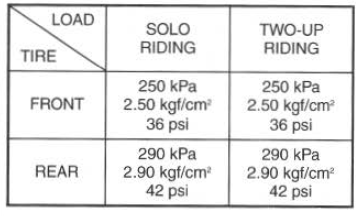Suzuki GSX-R 1000 Owners Manual: Tire pressure and loading
Proper tire pressure and proper tire loading are important factors.
Overloading your tires can lead to tire failure and loss of vehicle control.
Check tire pressure each day before you ride, and be sure the pressure is correct for the vehicle load according to the table below.
Tire pressure should only be checked and adjusted before riding, since riding will heat up the tires and lead to higher inflation pressure readings.
Under-inflated tires make smooth cornering difficult, and can result in rapid tire wear. Over-inflated tires have a smaller amount of tire in contact with the road, which can contribute to skidding and loss of control.
Note
: when you detect drops in tire pressure, check the tire for nails or other punctures, or a damaged wheel rim. Tubeless tires sometimes lose pressure gradually when punctured.

 Tires
Tires
Warning
Failure to follow these warnings
may result in an accident
due to tire failure. The tires on
your motorcycle form the crucial
link between your motorcycle
and the road ...
 Tire condition and type
Tire condition and type
Tire condition and tire type affect
motorcycle performance. Cuts or
cracks in the tires can lead to tire
failure and loss of motorcycle
control. Worn tires are susceptible
to puncture failures an ...
Other materials:
License plate light removal and installation
Removal
Remove the frame cover. Refer to “exterior parts
removal and installation” in section 9d (page 9d-
6).
Disconnect the license plate light coupler (1).
Remove the nuts.
Remove the license plate light assembly (2).
Installation
Install the license pl ...
Excv cable removal and installation
Removal
Turn the ignition switch off.
Remove the front seat. Refer to “exterior parts
removal and installation” in section 9d (page 9d-
6).
Remove the left side cowling. Refer to “exterior parts removal and
installation” in section 9d .
Connect the special tool (mo ...
Rear shock absorber removal and installation
Removal
Remove the right side cowling and side frame covers. Refer to “exterior
parts removal and installation” in section 9d .
Support the motorcycle with a jack to relieve load on
the rear shock absorber.
Remove the left muffler and muffler chamber heat guard no. 2. Refer ...
